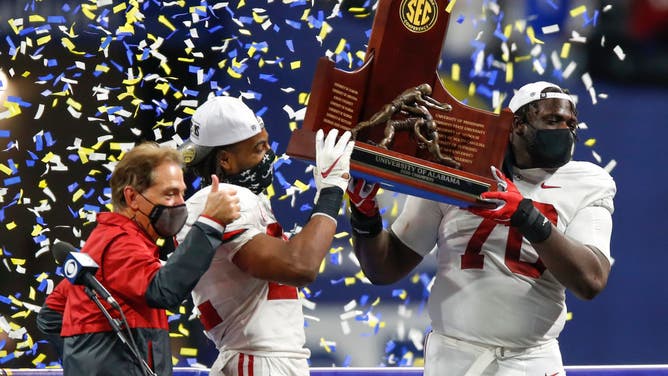Another Conference Realignment Wrinkle: SEC Must Balance Schedule With Revenue
As SEC expansion looms in the coming years, the fate of non-conference scheduling hangs in the balance.
Currently, the SEC plays eight conference games and four non-conference games. Of those four non-conference games, each school tends to maintain either a non-SEC rivalry based in geography (Florida-Florida State, Georgia-Georgia Tech, etc.), or aims to schedule one prestigious, splashy game that will help drive revenue and make a stronger case for postseason placement (Auburn plays Penn State this fall, for example). The rest are usually cupcake wins that the SEC literally buys: mid-major teams like Southern Miss collect a nice payday to receive their public flogging in Bryant-Denny or any other SEC stadium.
It’s a system that works, even though three other power conferences (Pac-12, Big Ten, and Big 12) all play nine conference games per season. In other words, even without the ‘extra’ competition, the SEC continues to put one if not two teams in the CFP each January. SEC detractors who fully believe the conference is unfairly worshipped because of television money like to use this little disparity as the crux of their argument: sure, the SEC has good teams, but their schedules are soft. Their insolence obviously fails to recognize the elite talent in the conference, as evidenced by the flood of NFL draftees each Spring from the South, but no problem, feel how you want to feel.
Well, these dolts are almost certainly going to get their wish: it’s hard to imagine that the SEC continues with just eight conference games once Texas and Oklahoma enter the fold. That ninth game will simply be too valuable; the revenues from a ninth SEC game with outpace any CFP goodwill or splashy interconference showdown by millions and millions of dollars.
Some well-respected SEC analysts agree.

(Photo by Todd Kirkland/Getty Images)
“I think you’ll still get the strong nonconference games,” SEC Network’s Cole Cubelic said. “I do think the SEC goes up. I think you have to add another conference game. You’re talking about $70 million per school (being distributed by the league). If that’s the case, the one thing I don’t want you doing anymore is going out and playing teams from other leagues. We’ll keep that money in-house. We’ll keep that money among ourselves. Why do we want to share that much revenue when we’re driving it in?
“It goes back to inventory. When you have the quality teams the SEC has, now by adding Oklahoma and Texas, the inventory that you’re going to be able to offer in your next television deal is going to be second to none. You’re not going to want to share that with too many other people, either. I don’t think they’ll go past 9 (conference games) because you still want to try to get as many teams in the College Football Playoff as you can. But the other part of this is we don’t know where the Playoff is going. … There are so many questions with where college football is going.”
And that’s the rub. Just how many conference games make the most sense for maximizing revenue and guaranteeing postseason availability? Right now, the margin for error to enter the playoff is razor-thin: one loss, at most, and that’s only if you win the conference championship game. But what happens if (when) the playoff expands? Do conference championship games go the way of the dodo? Do we lose the regular season non-conference Power 5 game, too? College football is too broad and unequal to really gauge quality without a massive dash of human perception, so at the end of the day, resume matters above all. The SEC wants to strengthen its product as much as possible without sacrificing the mythical glory of dominance that has put the conference in such a strong position these last fifteen years.
Whatever happens next, be prepared to see a whole new product on the field in the coming years.